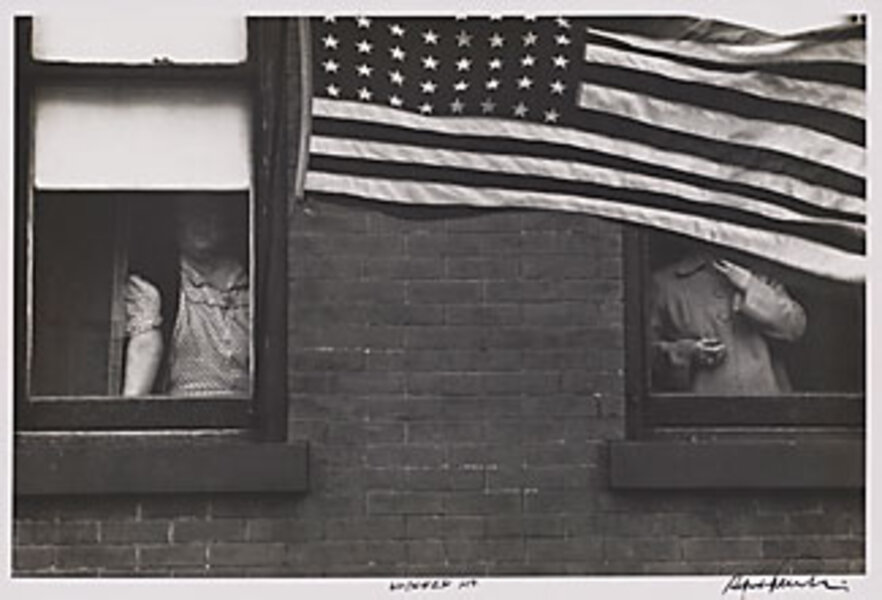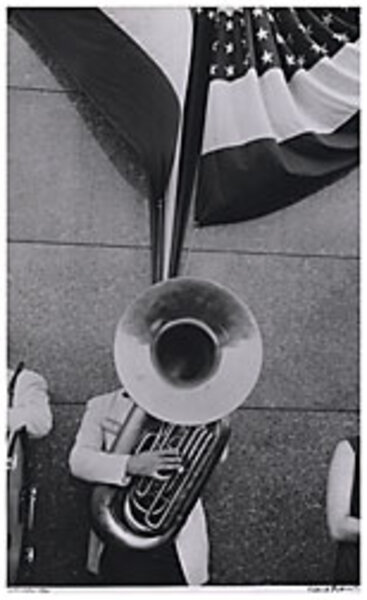Robert Frank: His photographs recorded an unvarnished America
| New York
In a 1985 video, photographer Robert Frank stated: "I am always looking outside, trying to look inside, trying to say something that is true." An exhibition at the Metropolitan Museum of Art through Jan. 3, 2010, "Looking In: Robert Frank's 'The Ameri-cans,' " displays the results of his quest. Honoring the 50th anniversary of the American publication of Frank's book of photographs, "The Americans," the show is the first time these 83 controversial prints have been exhibited in their entirety in a New York museum.
His photographs succeeded so brilliantly in expressing unvarnished truth that they produced a wail of shock when published in 1959. It took another outsider, Beat writer Jack Kerouac, to appreciate the book, saying in the introduction: "He sucked a sad poem right out of America onto film, taking rank among the tragic poets of the world."
Metropolitan curator of photographs Jeff Rosenheim seconds Kerouac's praise, saying Frank's book is "universally considered to be a landmark in 20th-century art." According to Sarah Greenough, senior curator of photographs at Washington's National Gallery of Art, who edited the catalog, "The Americans" is "among the most seminal photography books ever published" and "forever changed the course of 20th-century photography."
Such recognition was slow in coming. At first the photographs, which present a panoramic portrait of Americans at work and play, were construed as a diatribe against the American character. "Initially reviled, even decried by critics and photographers alike as anti-American, [the book] simply revealed too much," Mr. Rosenheim said in a panel discussion on the work. Among negative comments were dismissals like "a sad poem for sick people," "a slashing, bitter attack," and "a wart-covered picture of American institutions."
Only the fearless Barney Rosset, whose Grove Press dared to print untouchables like Samuel Beckett, Henry Miller, and D.H. Lawrence, risked publishing a tiny edition in the US. In the museum panel discussion, Mr. Rosset recalled seeing the photographs: "I recognized immediately the faces of ... people who were exuding emotions through their pores."
The photographs, he added, "have a magic abstraction. [Frank's] film carries the seed of what the viewer provides to make it come to life." To interpret the ambiguous, open-ended images, Rosset said the viewer "had to put yourself into those photographs, and no one could predict what would come out of that coalition of you and the photographer."
How the photographs came into existence is a story in itself. Frank, born in 1924 to German Jewish parents in Zurich, knew what it was like to feel in jeopardy as Hitler's armies closed in around Switzerland. He came to New York in 1947 seeking wider opportunities. He got one when the Guggenheim Foundation gave him a grant for a photographic survey of America, to reveal, in Frank's words, "the kind of civilization born here and spreading elsewhere." From 1955 to 1956 he traveled 10,000 miles in a used Ford, traversing more than 30 states and shooting 767 rolls of film.
The road trip was illuminating. A newcomer who was not yet an American citizen, Frank looked at the social scene through fresh eyes. What he discovered was not flattering. He was harassed and told to get out of town in Mississippi. He was surprised when an African-American hitchhiker refused to sit in the front seat with him, for fear of reprisal. In McGhee, Ark., Frank was arrested, simply for being an unshaven foreigner with New York license plates. He was thrown in jail, harshly interrogated on suspicion of having Communist ties, and threatened with violence.
These experiences opened his eyes to the pervasive racism in the South and abuse of those on the margins. "This experience was a catalyst for the intense emotional tenor" of the photographs, Rosenheim said, and instilled anger in Frank and identification with the powerless. The photographs still immerse a viewer in the underside of midcentury America: A time of cold-war fears, McCarthyism and suspicion of foreigners, segregation, alienation, and isolation – all of which Frank captures with unstinting candor.
The book makes its points subtly, without text except for captions giving date and locale. There are few smiles, no tourist shots of the Grand Canyon, and many unsettling images. The first – of two women watching a parade in Hoboken, N.J. – sets the tone. One figure is in shadow, the other's face obscured by an American flag. A joyous celebration? Hardly. Frank sees ordinary Americans as blinded by patriotism, eclipsed by the American dream.
Frank uses contrast to suggest meaning. A rich, bejeweled socialite at a New York charity ball projects haughty privilege, while the next photo shows a working-class man at his meager meal in a cafeteria. Voilà – the haves and have-nots. Frank alternates photographs devoid of life (a kind of pause in the cinematic progression) with portraits of lone figures and others of a lonely crowd, like old folks sitting back-to-back on benches in Florida, with absolutely no connection through eye contact or conversation.
His classic New Orleans streetcar scene distills the era's social hierarchy. In front is a white man, then a white woman, white boy, and girl, followed by an African-American man – his eyes a soulful lament – and an African-American woman. Basically, a frieze of race and gender, which Kerouac described as "the gray film that caught the actual pink juice of human kind."
Frank's revolutionary technique reinforces his underlying message of malaise. In style, Frank is more provocateur Michael Moore than easy-on-the-eye Michelangelo. Although once criticized as blurry, out-of-focus, and askew, with asymmetrical rather than carefully composed compositions, his style evokes raw emotion. Frank transformed documentary photography from objective, clear, and lucid to subjective, allusive, and elusive.
Frank, now 85 and as cantankerous as ever in public statements, took his road trip before seat belts and smooth interstate highways. If you ride with him, you'll be shaken up. You'll see a social landscape not pictured in postcards: no purple mountain majesties or amber waves of grain.
By 1969 when the book was reprinted, Americans were ready to acknowledge the substantive social issues he exposed. It's been a bumpy ride since then. We're still searching for the exit ramp.








